Neutron spectrum unfolding using various computer codes: A comparison
Dosimetric quantities at various distances from a 30 cm diameter
polyethylene sphere moderated 241Am-Be source were investigated using the Bonner
sphere spectrometer system. The different international commercial unfolding codes were
applied to unfold the neutron spectrum, and their shapes were compared to each other.
Additionally, the integrated neutron fluence rates overall spectrum and fractional neutron
fluence rates were deduced and compared between the results obtained from different
unfolding codes. As an important quantity applying in radiation safety assessment, the
neutron ambient dose equivalent rates were also calculated and compared to each other to
verify the utility feasibilities of the codes.

Trang 1
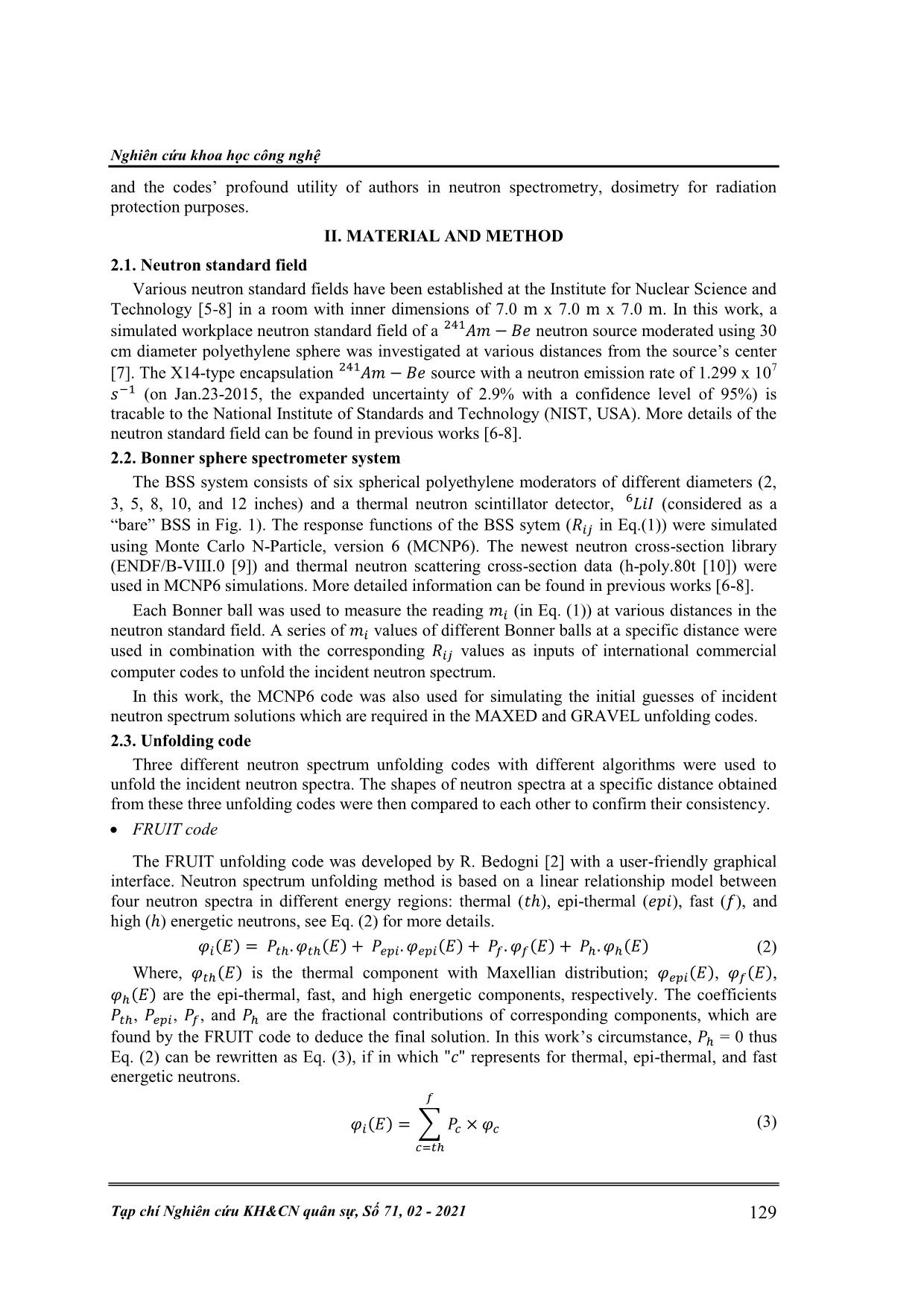
Trang 2
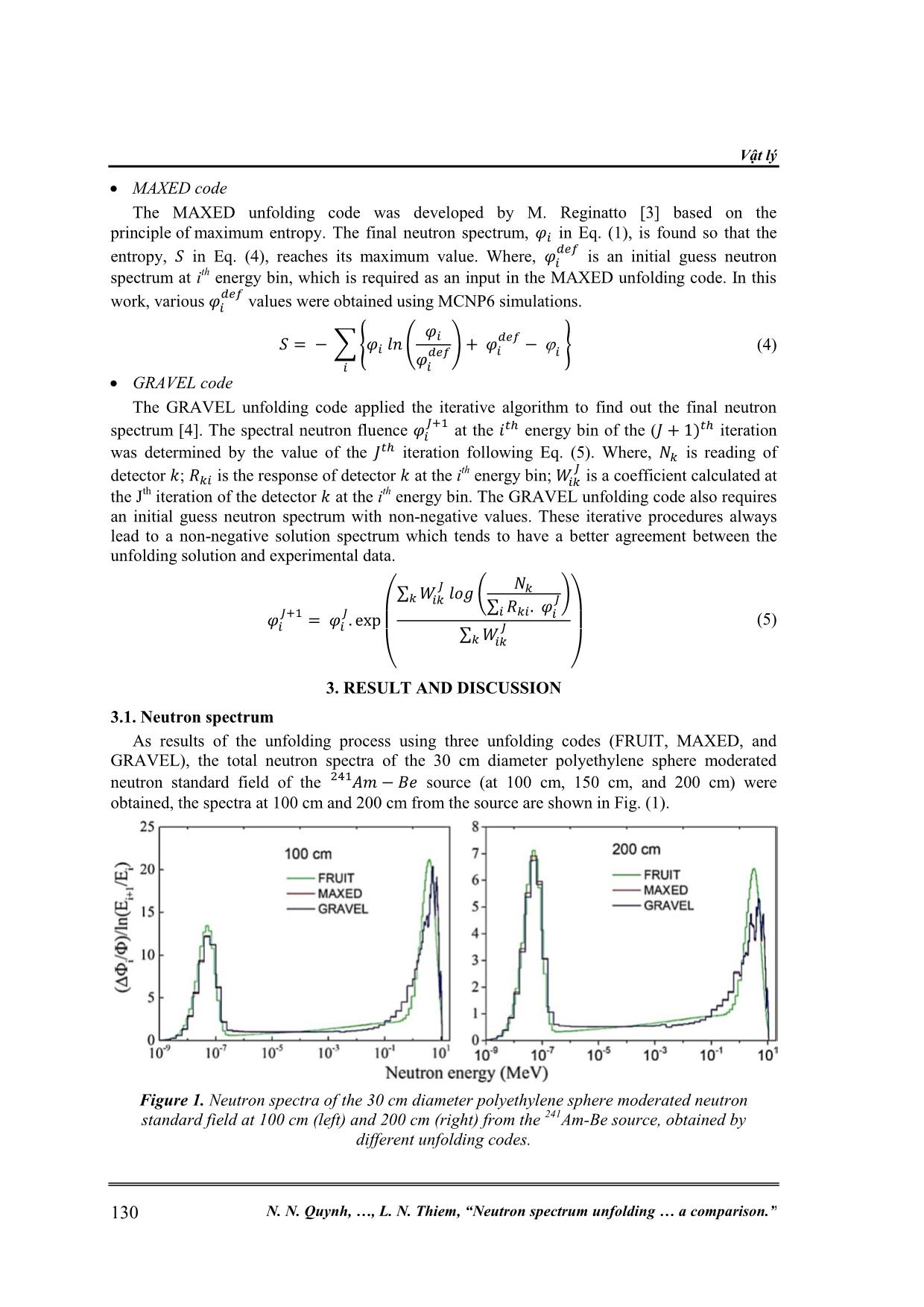
Trang 3
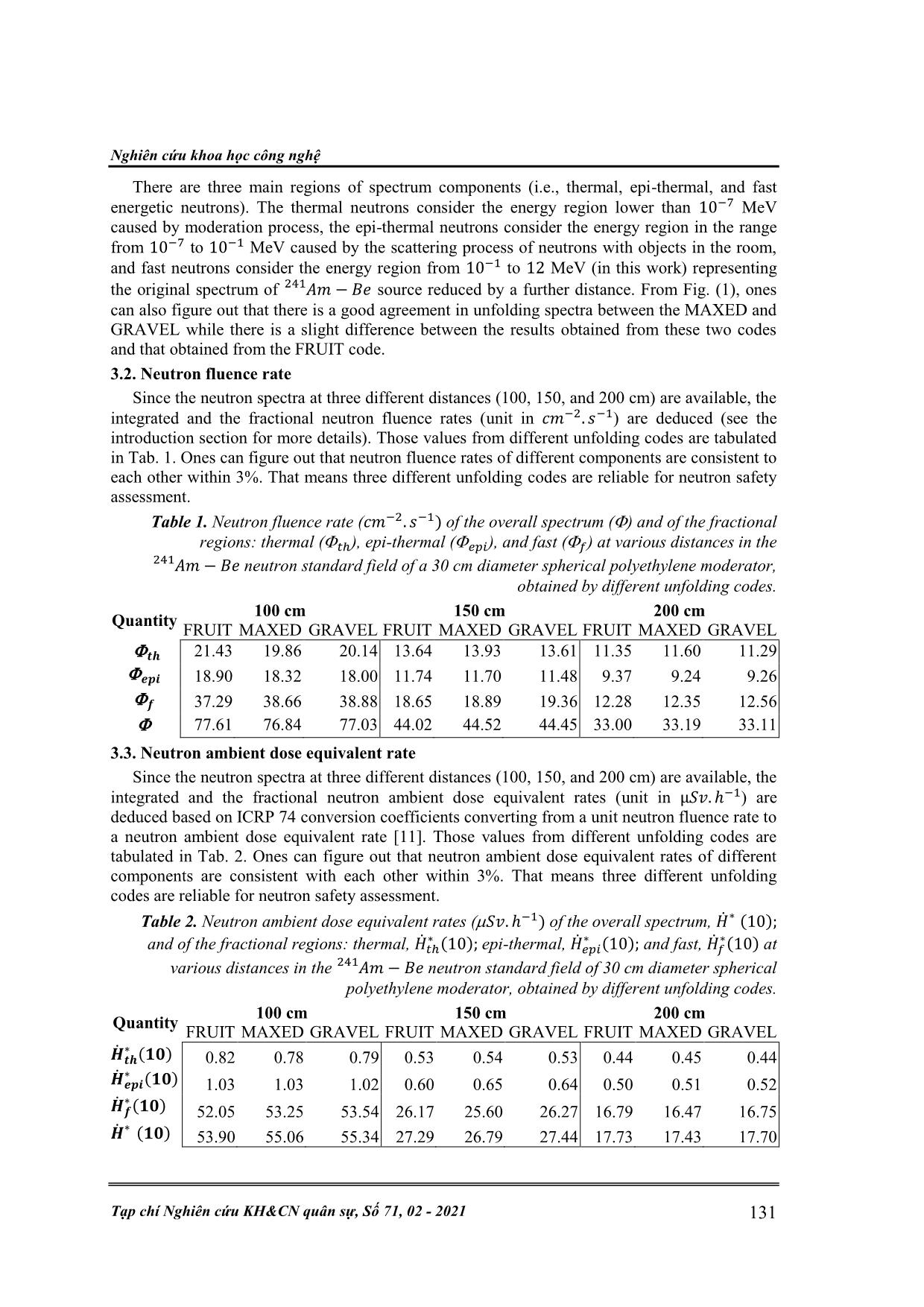
Trang 4
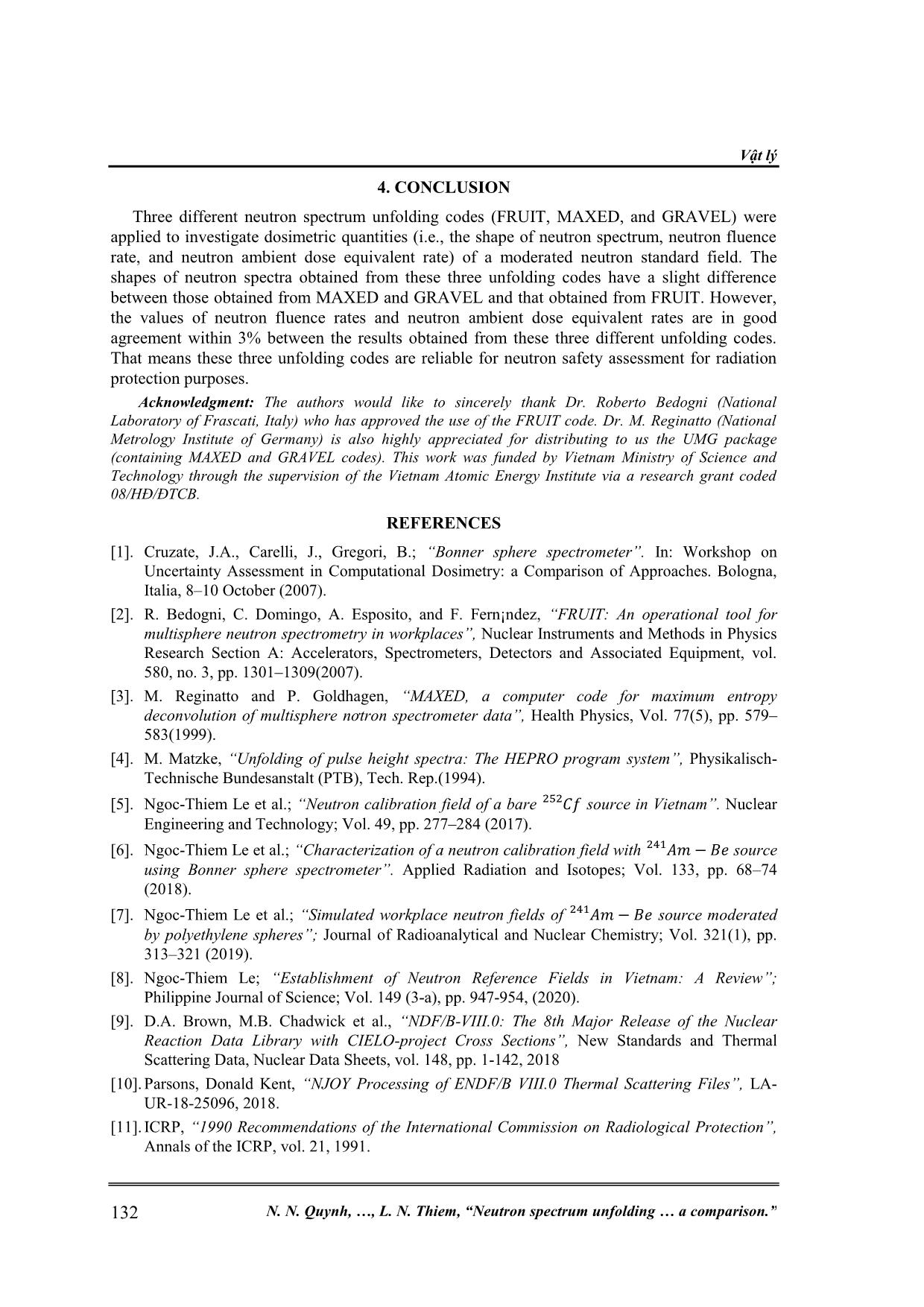
Trang 5
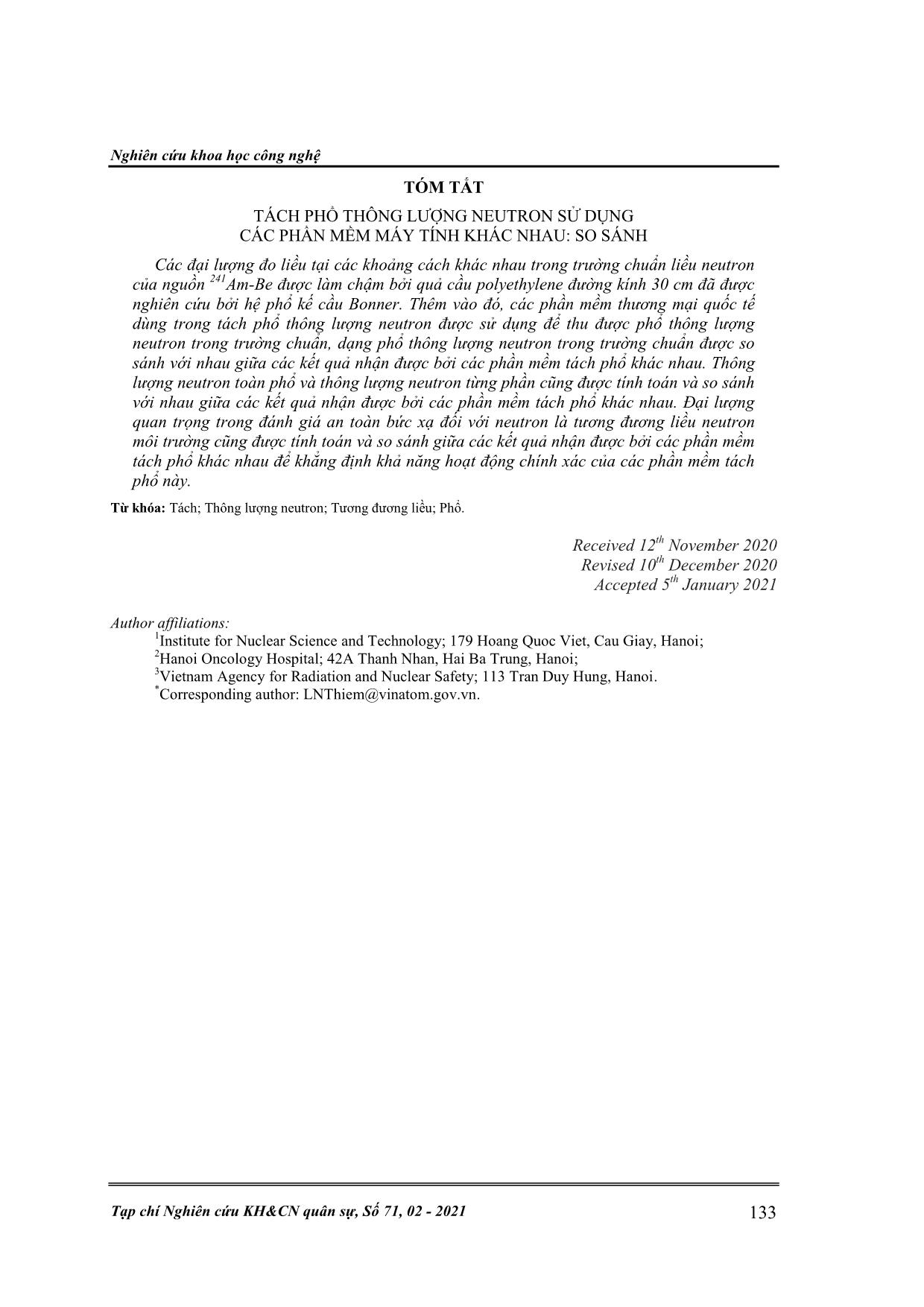
Trang 6
Tóm tắt nội dung tài liệu: Neutron spectrum unfolding using various computer codes: A comparison
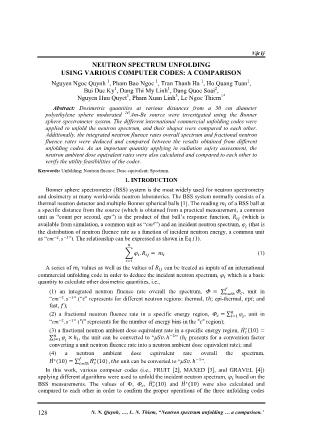
energy, a common unit
as “ ”). The relationship can be expressed as shown in Eq.(1).
∑ (1)
A series of values as well as the values of can be treated as inputs of an international
commercial unfolding code in order to deduce the incident neutron spectrum, which is a basic
quantity to calculate other dosimetric quantities, i.e.,
(1) an integrated neutron fluence rate overall the spectrum, ∑ , unit in
“ ” (“ represents for different neutron regions: thermal, ; epi-thermal, ; and
fast, );
(2) a fractional neutron fluence rate in a specific energy region, ∑ , unit in
“ ” ( represents for the number of energy bins in the region);
(3) a fractional neutron ambient dose equivalent rate in a specific energy region, ̇ ( )
∑ , the unit can be converted to “ ” ( presents for a conversion factor
converting a unit neutron fluence rate into a neutron ambient dose equivalent rate); and
(4) a neutron ambient dose equivalent rate overall the spectrum,
̇ ̇
( ) ∑ ( ) unit can be converted to “ ”.
In this work, various computer codes (i.e., FRUIT [2], MAXED [3], and GRAVEL [4])
applying different algorithms were used to unfold the incident neutron spectrum, based on the
BSS measurements. The values of , , ̇ ( ) and ̇ ( ) were also calculated and
compared to each other in order to confirm the proper operations of the three unfolding codes
128 N. N. Quynh, , L. N. Thiem, “Neutron spectrum unfolding a comparison.”
Nghiên cứu khoa học công nghệ
and the codes’ profound utility of authors in neutron spectrometry, dosimetry for radiation
protection purposes.
II. MATERIAL AND METHOD
2.1. Neutron standard field
Various neutron standard fields have been established at the Institute for Nuclear Science and
Technology [5-8] in a room with inner dimensions of 7.0 x 7.0 x 7.0 . In this work, a
simulated workplace neutron standard field of a neutron source moderated using 30
cm diameter polyethylene sphere was investigated at various distances from the source’s center
[7]. The X14-type encapsulation source with a neutron emission rate of 1.299 x 107
(on Jan.23-2015, the expanded uncertainty of 2.9% with a confidence level of 95%) is
tracable to the National Institute of Standards and Technology (NIST, USA). More details of the
neutron standard field can be found in previous works [6-8].
2.2. Bonner sphere spectrometer system
The BSS system consists of six spherical polyethylene moderators of different diameters (2,
3, 5, 8, 10, and 12 inches) and a thermal neutron scintillator detector, (considered as a
“bare” BSS in Fig. 1). The response functions of the BSS sytem ( in Eq.(1)) were simulated
using Monte Carlo N-Particle, version 6 (MCNP6). The newest neutron cross-section library
(ENDF/B-VIII.0 [9]) and thermal neutron scattering cross-section data (h-poly.80t [10]) were
used in MCNP6 simulations. More detailed information can be found in previous works [6-8].
Each Bonner ball was used to measure the reading (in Eq. (1)) at various distances in the
neutron standard field. A series of values of different Bonner balls at a specific distance were
used in combination with the corresponding values as inputs of international commercial
computer codes to unfold the incident neutron spectrum.
In this work, the MCNP6 code was also used for simulating the initial guesses of incident
neutron spectrum solutions which are required in the MAXED and GRAVEL unfolding codes.
2.3. Unfolding code
Three different neutron spectrum unfolding codes with different algorithms were used to
unfold the incident neutron spectra. The shapes of neutron spectra at a specific distance obtained
from these three unfolding codes were then compared to each other to confirm their consistency.
FRUIT code
The FRUIT unfolding code was developed by R. Bedogni [2] with a user-friendly graphical
interface. Neutron spectrum unfolding method is based on a linear relationship model between
four neutron spectra in different energy regions: thermal ( ), epi-thermal ( ), fast ( ), and
high ( ) energetic neutrons, see Eq. (2) for more details.
( ) ( ) ( ) ( ) ( ) (2)
Where, ( ) is the thermal component with Maxellian distribution; ( ), ( ),
( ) are the epi-thermal, fast, and high energetic components, respectively. The coefficients
, , , and are the fractional contributions of corresponding components, which are
found by the FRUIT code to deduce the final solution. In this work’s circumstance, = 0 thus
Eq. (2) can be rewritten as Eq. (3), if in which represents for thermal, epi-thermal, and fast
energetic neutrons.
( ) ∑ (3)
Tạp chí Nghiên cứu KH&CN quân sự, Số 71, 02 - 2021 129
Vật lý
MAXED code
The MAXED unfolding code was developed by M. Reginatto [3] based on the
principle of maximum entropy. The final neutron spectrum, in Eq. (1), is found so that the
entropy, in Eq. (4), reaches its maximum value. Where, is an initial guess neutron
spectrum at ith energy bin, which is required as an input in the MAXED unfolding code. In this
work, various values were obtained using MCNP6 simulations.
∑ { ( ) } (4)
GRAVEL code
The GRAVEL unfolding code applied the iterative algorithm to find out the final neutron
spectrum [4]. The spectral neutron fluence at the energy bin of the ( ) iteration
was determined by the value of the iteration following Eq. (5). Where, is reading of
th
detector ; is the response of detector at the i energy bin; is a coefficient calculated at
the Jth iteration of the detector at the ith energy bin. The GRAVEL unfolding code also requires
an initial guess neutron spectrum with non-negative values. These iterative procedures always
lead to a non-negative solution spectrum which tends to have a better agreement between the
unfolding solution and experimental data.
∑ ( )
∑
(5)
∑
( )
3. RESULT AND DISCUSSION
3.1. Neutron spectrum
As results of the unfolding process using three unfolding codes (FRUIT, MAXED, and
GRAVEL), the total neutron spectra of the 30 cm diameter polyethylene sphere moderated
neutron standard field of the source (at 100 cm, 150 cm, and 200 cm) were
obtained, the spectra at 100 cm and 200 cm from the source are shown in Fig. (1).
Figure 1. Neutron spectra of the 30 cm diameter polyethylene sphere moderated neutron
standard field at 100 cm (left) and 200 cm (right) from the 241Am-Be source, obtained by
different unfolding codes.
130 N. N. Quynh, , L. N. Thiem, “Neutron spectrum unfolding a comparison.”
Nghiên cứu khoa học công nghệ
There are three main regions of spectrum components (i.e., thermal, epi-thermal, and fast
energetic neutrons). The thermal neutrons consider the energy region lower than MeV
caused by moderation process, the epi-thermal neutrons consider the energy region in the range
from to MeV caused by the scattering process of neutrons with objects in the room,
and fast neutrons consider the energy region from to MeV (in this work) representing
the original spectrum of source reduced by a further distance. From Fig. (1), ones
can also figure out that there is a good agreement in unfolding spectra between the MAXED and
GRAVEL while there is a slight difference between the results obtained from these two codes
and that obtained from the FRUIT code.
3.2. Neutron fluence rate
Since the neutron spectra at three different distances (100, 150, and 200 cm) are available, the
integrated and the fractional neutron fluence rates (unit in ) are deduced (see the
introduction section for more details). Those values from different unfolding codes are tabulated
in Tab. 1. Ones can figure out that neutron fluence rates of different components are consistent to
each other within 3%. That means three different unfolding codes are reliable for neutron safety
assessment.
Table 1. Neutron fluence rate ( ) of the overall spectrum ( ) and of the fractional
regions: thermal ( ), epi-thermal ( ), and fast ( ) at various distances in the
neutron standard field of a 30 cm diameter spherical polyethylene moderator,
obtained by different unfolding codes.
100 cm 150 cm 200 cm
Quantity
FRUIT MAXED GRAVEL FRUIT MAXED GRAVEL FRUIT MAXED GRAVEL
21.43 19.86 20.14 13.64 13.93 13.61 11.35 11.60 11.29
18.90 18.32 18.00 11.74 11.70 11.48 9.37 9.24 9.26
37.29 38.66 38.88 18.65 18.89 19.36 12.28 12.35 12.56
77.61 76.84 77.03 44.02 44.52 44.45 33.00 33.19 33.11
3.3. Neutron ambient dose equivalent rate
Since the neutron spectra at three different distances (100, 150, and 200 cm) are available, the
integrated and the fractional neutron ambient dose equivalent rates (unit in ) are
deduced based on ICRP 74 conversion coefficients converting from a unit neutron fluence rate to
a neutron ambient dose equivalent rate [11]. Those values from different unfolding codes are
tabulated in Tab. 2. Ones can figure out that neutron ambient dose equivalent rates of different
components are consistent with each other within 3%. That means three different unfolding
codes are reliable for neutron safety assessment.
Table 2. Neutron ambient dose equivalent rates ( ) of the overall spectrum, ̇ ( )
and of the fractional regions: thermal, ̇ ( ) epi-thermal, ̇ ( ) and fast, ̇ ( ) at
various distances in the neutron standard field of 30 cm diameter spherical
polyethylene moderator, obtained by different unfolding codes.
100 cm 150 cm 200 cm
Quantity
FRUIT MAXED GRAVEL FRUIT MAXED GRAVEL FRUIT MAXED GRAVEL
̇
( ) 0.82 0.78 0.79 0.53 0.54 0.53 0.44 0.45 0.44
̇
( ) 1.03 1.03 1.02 0.60 0.65 0.64 0.50 0.51 0.52
̇
( ) 52.05 53.25 53.54 26.17 25.60 26.27 16.79 16.47 16.75
̇ ( ) 53.90 55.06 55.34 27.29 26.79 27.44 17.73 17.43 17.70
Tạp chí Nghiên cứu KH&CN quân sự, Số 71, 02 - 2021 131
Vật lý
4. CONCLUSION
Three different neutron spectrum unfolding codes (FRUIT, MAXED, and GRAVEL) were
applied to investigate dosimetric quantities (i.e., the shape of neutron spectrum, neutron fluence
rate, and neutron ambient dose equivalent rate) of a moderated neutron standard field. The
shapes of neutron spectra obtained from these three unfolding codes have a slight difference
between those obtained from MAXED and GRAVEL and that obtained from FRUIT. However,
the values of neutron fluence rates and neutron ambient dose equivalent rates are in good
agreement within 3% between the results obtained from these three different unfolding codes.
That means these three unfolding codes are reliable for neutron safety assessment for radiation
protection purposes.
Acknowledgment: The authors would like to sincerely thank Dr. Roberto Bedogni (National
Laboratory of Frascati, Italy) who has approved the use of the FRUIT code. Dr. M. Reginatto (National
Metrology Institute of Germany) is also highly appreciated for distributing to us the UMG package
(containing MAXED and GRAVEL codes). This work was funded by Vietnam Ministry of Science and
Technology through the supervision of the Vietnam Atomic Energy Institute via a research grant coded
08/HĐ/ĐTCB.
REFERENCES
[1]. Cruzate, J.A., Carelli, J., Gregori, B.; “Bonner sphere spectrometer”. In: Workshop on
Uncertainty Assessment in Computational Dosimetry: a Comparison of Approaches. Bologna,
Italia, 8–10 October (2007).
[2]. R. Bedogni, C. Domingo, A. Esposito, and F. Fern¡ndez, “FRUIT: An operational tool for
multisphere neutron spectrometry in workplaces”, Nuclear Instruments and Methods in Physics
Research Section A: Accelerators, Spectrometers, Detectors and Associated Equipment, vol.
580, no. 3, pp. 1301–1309(2007).
[3]. M. Reginatto and P. Goldhagen, “MAXED, a computer code for maximum entropy
deconvolution of multisphere nơtron spectrometer data”, Health Physics, Vol. 77(5), pp. 579–
583(1999).
[4]. M. Matzke, “Unfolding of pulse height spectra: The HEPRO program system”, Physikalisch-
Technische Bundesanstalt (PTB), Tech. Rep.(1994).
[5]. Ngoc-Thiem Le et al.; “Neutron calibration field of a bare source in Vietnam”. Nuclear
Engineering and Technology; Vol. 49, pp. 277–284 (2017).
[6]. Ngoc-Thiem Le et al.; “Characterization of a neutron calibration field with source
using Bonner sphere spectrometer”. Applied Radiation and Isotopes; Vol. 133, pp. 68–74
(2018).
[7]. Ngoc-Thiem Le et al.; “Simulated workplace neutron fields of source moderated
by polyethylene spheres”; Journal of Radioanalytical and Nuclear Chemistry; Vol. 321(1), pp.
313–321 (2019).
[8]. Ngoc-Thiem Le; “Establishment of Neutron Reference Fields in Vietnam: A Review”;
Philippine Journal of Science; Vol. 149 (3-a), pp. 947-954, (2020).
[9]. D.A. Brown, M.B. Chadwick et al., “NDF/B-VIII.0: The 8th Major Release of the Nuclear
Reaction Data Library with CIELO-project Cross Sections”, New Standards and Thermal
Scattering Data, Nuclear Data Sheets, vol. 148, pp. 1-142, 2018
[10]. Parsons, Donald Kent, “NJOY Processing of ENDF/B VIII.0 Thermal Scattering Files”, LA-
UR-18-25096, 2018.
[11]. ICRP, “1990 Recommendations of the International Commission on Radiological Protection”,
Annals of the ICRP, vol. 21, 1991.
132 N. N. Quynh, , L. N. Thiem, “Neutron spectrum unfolding a comparison.”
Nghiên cứu khoa học công nghệ
TÓM TẮT
TÁCH PHỔ THÔNG LƯỢNG NEUTRON SỬ DỤNG
CÁC PHẦN MỀM MÁY TÍNH KHÁC NHAU: SO SÁNH
Các đại lượng đo liều tại các khoảng cách khác nhau trong trường chuẩn liều neutron
của nguồn 241Am-Be được làm chậm bởi quả cầu polyethylene đường kính 30 cm đã được
nghiên cứu bởi hệ phổ kế cầu Bonner. Thêm vào đó, các phần mềm thương mại quốc tế
dùng trong tách phổ thông lượng neutron được sử dụng để thu được phổ thông lượng
neutron trong trường chuẩn, dạng phổ thông lượng neutron trong trường chuẩn được so
sánh với nhau giữa các kết quả nhận được bởi các phần mềm tách phổ khác nhau. Thông
lượng neutron toàn phổ và thông lượng neutron từng phần cũng được tính toán và so sánh
với nhau giữa các kết quả nhận được bởi các phần mềm tách phổ khác nhau. Đại lượng
quan trọng trong đánh giá an toàn bức xạ đối với neutron là tương đương liều neutron
môi trường cũng được tính toán và so sánh giữa các kết quả nhận được bởi các phần mềm
tách phổ khác nhau để khẳng định khả năng hoạt động chính xác của các phần mềm tách
phổ này.
Từ khóa: Tách; Thông lượng neutron; Tương đương liều; Phổ.
Received 12th November 2020
Revised 10th December 2020
Accepted 5th January 2021
Author affiliations:
1Institute for Nuclear Science and Technology; 179 Hoang Quoc Viet, Cau Giay, Hanoi;
2Hanoi Oncology Hospital; 42A Thanh Nhan, Hai Ba Trung, Hanoi;
3Vietnam Agency for Radiation and Nuclear Safety; 113 Tran Duy Hung, Hanoi.
*Corresponding author: LNThiem@vinatom.gov.vn.
Tạp chí Nghiên cứu KH&CN quân sự, Số 71, 02 - 2021 133 File đính kèm:
 neutron_spectrum_unfolding_using_various_computer_codes_a_co.pdf
neutron_spectrum_unfolding_using_various_computer_codes_a_co.pdf

